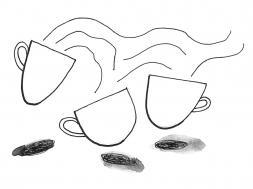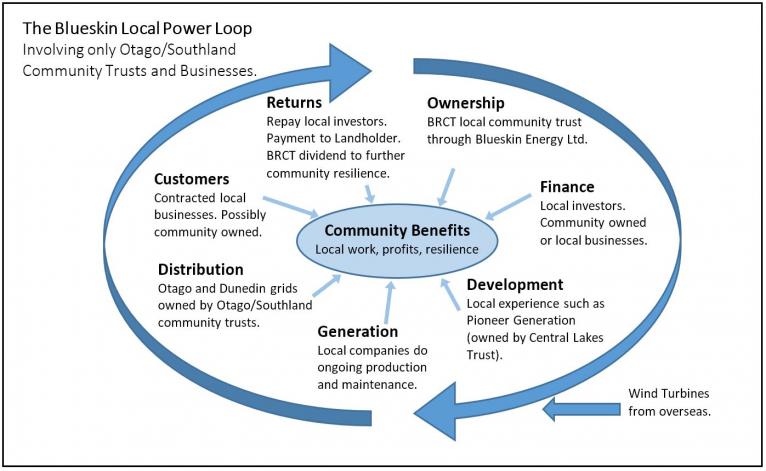John Kaiser
John has lived in Waitati since the early 1990s and now splits his time between Waitati and Dunedin. He has closely followed the alternative energy debate in Waitati and conceived this piece towards the end of his 20-year career in IT at the University of Otago. These days he volunteers two days a week doing admin for the Blueskin Resilient Communities Trust.

Eliminating the corporate power slice
Posted on 22 November 2015
by John Kaiser
Keeping power generation, distribution, and retailing local and community-owned
I have been intending to write this article for more than three years and it was finally written in September 2015. Since March 2015 I have been working part-time for the Blueskin Resilient Communities Trust (BRCT) as a volunteer, which means I now have access to updated information on its wind turbine initiative. I therefore acknowledge the input Scott Willis of the BRCT has had in factually checking this article and suggesting a few changes to accurately reflect the current position of the project.
I have had a long-time interest in the work Blueskin Resilient Communities Trust (BRCT) does in supporting initiatives that lead to resilient communities and, in particular, its ongoing investigation of local wind power generation. After all, we have known since at least the 1980s that global warming was probable and we needed to diversify our energy sources.
When BRCT first started talking about green energy production at a community level in 2007 I thought that might mean windmills and photo-voltaics for households or groups of households. I was quite surprised when a commercial-sized wind farm in the local area was suggested. It did not fit in with my concepts of “alternative” and “local”, even though I thought wind farms were a really good idea for diversifying a national power provider. However, examples of European community-owned wind farms were inspiring and, watching the BRCT project progressing, I had to revise my ideas.
Three related issues impacted my views:
Climate change and the need for local resilience
Growing inequality of wealth and living standards in New Zealand
The increasing control of our resources by large national and multi-national corporations.
I have come to see the development of a Blueskin wind farm as a way of addressing all three issues, so long as investment, production, distribution, and retailing are kept as much as possible within a local community-owned or local business framework. It will be great to have local sustainable power making the Blueskin community more resilient. Moreover, as many of the businesses likely to be involved are community-owned, returns will indirectly address the growing wealth inequality in our community. It will also diminish the involvement of national and trans-national corporations in our power system and stem the flow of profits out of our region.
Here is how a locally owned solution could be structured.

Ownership
There are, of course, many overseas examples of communities setting up local power generation entities. A legal report that the BRCT got on the options for community ownership indicated that, under current New Zealand law, a company structure with appropriate constitutional restraints was the only realistic option. The report also indicated that the company rules and constitution could be written up to maintain the values of the local community. So, a community-owned company set up to build and run a wind farm could work. The progress BRCT has made has excited many people and organisations across New Zealand, who see it as a blueprint for other communities to take control of their power generation needs.
Financing
While power generation from a local wind farm would be good from a resilience and a “keep it local” perspective, clearly, financing wind turbines within the community was a real issue. Some in the community are rightly concerned that there are other household issues more pressing, such as insulation and making ends meet. The local community cannot afford to finance a small wind farm all on its own, especially as there are many low-income households in Blueskin that would benefit from cheaper power but don’t have investment capital. A local windfarm could, however, be funded from a mix of crowd-funded equity and local investment, along with some debt, all secured by long-term power purchase contracts to supply one or more local institutions. This model maintains local community ownership and control and the possibility of a community dividend. If the investors are local then the national and international players are sidelined and profits return to the local area. If the investors themselves are community-owned then there is an even better return to the community.
Development and Generation
To be professional and successful, development and production requires organisations that are experienced. BRCT has been working with Pioneer Generation, an Otago-based company that already owns several wind farms and hydro schemes; if they were to become further involved, they certainly have the required local knowledge to assist with building and maintaining a wind farm. Other Otago-based businesses would also be involved in building and running a wind farm. I really support well -un community owned businesses like Pioneer Generation which is 100% owned by the Central Lakes Trust and pays the Central Lakes Trust an annual dividend, which is invested back into the community via community grants. [Editor’s note: The Central Lakes Trust trust has provided more than $75million to community projects in the Central Otago and Lakes districts since it was established in 2000.]
Distribution
The relationship of a local wind farm to the power grid is critical in terms of ease of connection and providing local power to the community. The Blueskin Bay local power grid is a fairly self-contained section of the national grid. In the past this has meant less reliable power distribution. A local wind farm will add to the resilience of our network.
The Blueskin grid is owned by Otago and Southland-based community-owned trusts through the joint venture OtagoNet. In Dunedin, city power is distributed by the DCC-owned Aurora Energy Ltd. So the distribution grid which is an essential element of the project is owned by companies based south of the Waitaki River. That they are also community-owned adds a further community benefit to the project.
Retailing the power
The current retailing environment makes selling power directly to local users difficult, although over the last few years small retail companies have emerged alongside the larger generator/retailers (also called “gentailers”). However, rather than set up a small retail company, a simpler way to sell our sustainable power would be to secure a power purchase agreement with one or more larger power consumers. This provides a guaranteed income to act as security against any money borrowed to finance the project.
This approach again challenged my concepts of local power for the benefit of the community. However, a number of local organisations and industries may be interested in securing local green electricity through a power purchase agreement. Some of these are community-owned, such as the Dunedin City Council, Otago Polytechnic, Port Otago, the University of Otago, and the Otago Regional Council.
The cost of the power would, of course, need to cover the cost of financing and producing the electricity. BRCT intends to secure a long term community dividend that will be used to support community projects in line with the BRCT vision and values. This dividend will reflect the extensive work done to get the scheme up and running.
Closing the loop
Putting all of the pieces of the puzzle together, we could achieve a comprehensive plan for a local wind farm involving only Otago and Southland community-owned organisations and local businesses for financing, managing, and purchasing our power. The community benefits because work and money remain local, and through support given to a range of projects and issues to build greater resilience including addressing fuel poverty.
The only national or international involvement would be purchasing the turbines and the services of a market participant to cover the legal electricity market requirements.
To summarise, the benefits are:
Local resilient power generation
Sustainable energy generation for our larger community with fewer overheads
Curtailing the power of the large, vertically integrated international and national corporations in our community, especially those that send profits overseas
Avoiding the need for expensive advertising and well-paid managers
Denying profits to a fundamentally monopolistic industry and instead distributing them within the Otago/Southland community
Returning benefits to the community through a community dividend, thus reducing the inequality of wealth and resources within the community
Providing a benchmark for lower power prices across the community over time
A long-term aim for the Blueskin community could also be the ownership or management of the Blueskin section of the national grid with the aim of being a net exporter of sustainable energy from the wind farm and individual household generation. Refunds to consumers already made by the community-owned Network Waitaki Ltd show what can be done.
Risks
There are risks for everybody in a community-owned wind farm project that is a NZ first. Those risks need to be carefully managed. However, I hope that the non-financial benefit of local resilience, work, and profits will be factored into any decisions by those involved. Disruptive technologies such as household photo-voltaics need to be considered. Household photo-voltaics and cheap power storage technologies transform our reliance on power from the grid. Changes within the local market also need to be considered, including possible closing of the Tiwai Point aluminium smelter. Blueskin Energy Ltd must be cautious and conservative in approach and must mitigate those risks.
A locally owned framework for sustainable power generation.
| ||||
| LOCAL – Otago, Southland | National, International | ||
| Local Input. Community owned | Local Input. Private | Local Benefits. |
|
Ownership | Blueskin Energy Ltd. |
| BRCT Dividend for Community activity. |
|
Financing | Local Investors. Possibly including major clients for the power | Local Investors. Possibly including major clients for the power | Good return on investment |
|
Turbine Purchase |
|
|
| Turbines bought from overseas |
Development and Construction | Blueskin Energy Ltd. Local partner
| Local partner, subcontractors | Local employment | Turbine company |
Land |
| Local landowner | Land lease income |
|
Generation | Maintenance contract. | Maintenance contract. Local contractors | Local employment. |
|
Distribution | OtagoNet Aurora |
| Local employment.
|
|
Consumers | Possible clients. DCC, ORC, Port Otago, Schools, local residents etc. | Other local clients. Univ. of Otago, Otago Polytech, local businesses | Long-term local sustainable power at a good price. |
|